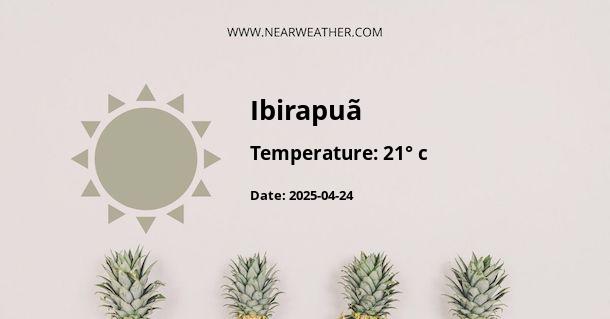Ibirapuã, Brazil: A Comprehensive Guide to its Climate and Weather Year Round
Ibirapuã, located in the state of Bahia, Brazil, boasts a tropical monsoon climate. This means that the town experiences distinct wet and dry seasons throughout the year. Understanding the climate and weather patterns in Ibirapuã is crucial for visitors and residents alike to plan and prepare for outdoor activities, agricultural practices, and various other aspects of daily life.
Annual Climate Overview
The climate in Ibirapuã is characterized by consistently high temperatures throughout the year, with distinct wet and dry seasons. The town experiences heavy rainfall during the wet season, which is essential for the region's lush vegetation and agricultural activities. Here is an overview of the climate in Ibirapuã:
| Month | Average High (°C) | Average Low (°C) | Rainfall (mm) |
|---|---|---|---|
| January | 31 | 22 | 120 |
| February | 31 | 22 | 110 |
| March | 31 | 22 | 130 |
| April | 30 | 22 | 190 |
| May | 29 | 21 | 250 |
| June | 28 | 20 | 270 |
| July | 28 | 19 | 230 |
| August | 29 | 20 | 200 |
| September | 29 | 21 | 170 |
| October | 30 | 22 | 150 |
| November | 30 | 22 | 130 |
| December | 31 | 22 | 120 |
As depicted in the table, temperatures in Ibirapuã remain relatively high throughout the year, with average highs ranging from 28°C to 31°C. The town experiences the highest rainfall from November to March, with May and June being the wettest months. The dry season, from July to September, sees a significant reduction in rainfall, making it the best time for outdoor activities and agricultural pursuits.
Weather Variability and Extremes
While Ibirapuã generally experiences consistent tropical weather, occasional variability and extremes can occur. Tropical storms and cyclones, albeit rare, can impact the region, especially during the wet season. These weather events can bring heavy rainfall, strong winds, and temporary disruptions to daily life.
Additionally, temperature variability within a day, with warmer days and cooler nights, is common in Ibirapuã. Relative humidity remains high throughout the year, contributing to the town's lush greenery and vibrant ecosystem.
Impacts on Agriculture and Environment
The climate in Ibirapuã significantly influences the region's agricultural practices and environmental sustainability. The ample rainfall during the wet season supports diverse agricultural activities, including the cultivation of tropical fruits such as banana, cocoa, and papaya. The dry season, on the other hand, necessitates efficient water management and irrigation techniques to sustain agricultural productivity.
The town's rich biodiversity and dense vegetation thrive under the tropical monsoon climate, contributing to its ecological significance and natural beauty. The climate also influences the migration patterns of wildlife, offering unique opportunities for ecological observation and conservation efforts.
Conclusion
Ibirapuã's tropical monsoon climate, characterized by distinct wet and dry seasons, shapes the town's environment, economy, and daily life. Understanding the climate and weather patterns is essential for residents, visitors, and industries to make informed decisions and adapt to the region's natural dynamics. Whether experiencing the lush greenery of the wet season or partaking in outdoor activities during the dry season, Ibirapuã offers a captivating experience shaped by its unique climate.
A - Ibirapuã's Latitude is -17.687780 & Longitude is -40.109169.
A - Weather in Ibirapuã is 19° today.
A - Climate Conditions in Ibirapuã shows clear sky today.
A - Humidity in Ibirapuã is 95% today.
A - Wind speed in Ibirapuã is 9.29 km/h, flowing at 59° wind direction. today.
